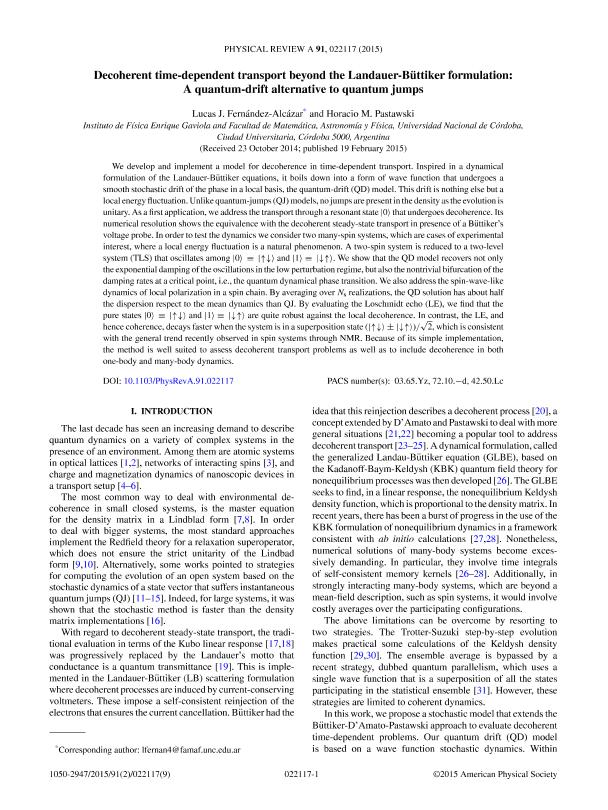Mostrar el registro sencillo del ítem
dc.contributor.author
Fernández, Lucas Jonatan

dc.contributor.author
Pastawski, Horacio Miguel

dc.date.available
2018-07-04T15:44:37Z
dc.date.issued
2015-02
dc.identifier.citation
Fernández, Lucas Jonatan; Pastawski, Horacio Miguel; Decoherent time-dependent transport beyond the Landauer-Büttiker formulation: A quantum-drift alternative to quantum jumps; American Physical Society; Physical Review A: Atomic, Molecular and Optical Physics; 91; 2; 2-2015; 22117-22117
dc.identifier.issn
1050-2947
dc.identifier.uri
http://hdl.handle.net/11336/51182
dc.description.abstract
We develop and implement a model for decoherence in time-dependent transport. Inspired in a dynamical formulation of the Landauer-Büttiker equations, it boils down into a form of wave function that undergoes a smooth stochastic drift of the phase in a local basis, the quantum-drift (QD) model. This drift is nothing else but a local energy fluctuation. Unlike quantum-jumps (QJ) models, no jumps are present in the density as the evolution is unitary. As a first application, we address the transport through a resonant state |0〉 that undergoes decoherence. Its numerical resolution shows the equivalence with the decoherent steady-state transport in presence of a Büttiker's voltage probe. In order to test the dynamics we consider two many-spin systems, which are cases of experimental interest, where a local energy fluctuation is a natural phenomenon. A two-spin system is reduced to a two-level system (TLS) that oscillates among |0〉≡|↑↓〉 and |1〉≡|↓↑〉. We show that the QD model recovers not only the exponential damping of the oscillations in the low perturbation regime, but also the nontrivial bifurcation of the damping rates at a critical point, i.e., the quantum dynamical phase transition. We also address the spin-wave-like dynamics of local polarization in a spin chain. By averaging over Ns realizations, the QD solution has about half the dispersion respect to the mean dynamics than QJ. By evaluating the Loschmidt echo (LE), we find that the pure states |0〉≡|↑↓〉 and |1〉≡|↓↑〉 are quite robust against the local decoherence. In contrast, the LE, and hence coherence, decays faster when the system is in a superposition state (|↑↓〉±|↓↑〉)/2, which is consistent with the general trend recently observed in spin systems through NMR. Because of its simple implementation, the method is well suited to assess decoherent transport problems as well as to include decoherence in both one-body and many-body dynamics.
dc.format
application/pdf
dc.language.iso
eng
dc.publisher
American Physical Society

dc.rights
info:eu-repo/semantics/openAccess
dc.rights.uri
https://creativecommons.org/licenses/by-nc-sa/2.5/ar/
dc.subject
Dynamical Quantum Transport
dc.subject
Decoherence
dc.subject
Loschmidt Echo
dc.subject
Mesoscopic Echo
dc.subject.classification
Astronomía

dc.subject.classification
Ciencias Físicas

dc.subject.classification
CIENCIAS NATURALES Y EXACTAS

dc.title
Decoherent time-dependent transport beyond the Landauer-Büttiker formulation: A quantum-drift alternative to quantum jumps
dc.type
info:eu-repo/semantics/article
dc.type
info:ar-repo/semantics/artículo
dc.type
info:eu-repo/semantics/publishedVersion
dc.date.updated
2018-07-03T21:53:11Z
dc.journal.volume
91
dc.journal.number
2
dc.journal.pagination
22117-22117
dc.journal.pais
Estados Unidos

dc.journal.ciudad
Nueva York
dc.description.fil
Fil: Fernández, Lucas Jonatan. Consejo Nacional de Investigaciones Científicas y Técnicas. Centro Científico Tecnológico Conicet - Córdoba. Instituto de Física Enrique Gaviola. Universidad Nacional de Córdoba. Instituto de Física Enrique Gaviola; Argentina. Universidad Nacional de Córdoba. Facultad de Matemática, Astronomía y Física; Argentina
dc.description.fil
Fil: Pastawski, Horacio Miguel. Consejo Nacional de Investigaciones Científicas y Técnicas. Centro Científico Tecnológico Conicet - Córdoba. Instituto de Física Enrique Gaviola. Universidad Nacional de Córdoba. Instituto de Física Enrique Gaviola; Argentina. Universidad Nacional de Córdoba. Facultad de Matemática, Astronomía y Física; Argentina
dc.journal.title
Physical Review A: Atomic, Molecular and Optical Physics

dc.relation.alternativeid
info:eu-repo/semantics/altIdentifier/doi/https://dx.doi.org/10.1103/PhysRevA.91.022117
dc.relation.alternativeid
info:eu-repo/semantics/altIdentifier/url/https://journals.aps.org/pra/abstract/10.1103/PhysRevA.91.022117
Archivos asociados
